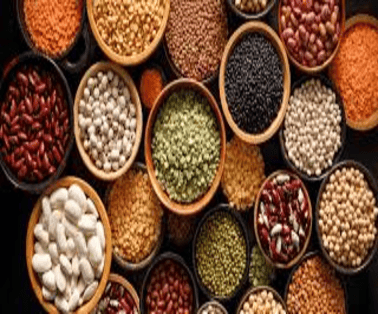India’s pulses imports in fiscal 2024 witnessed a remarkable surge, soaring by 84% year-on-year to their highest level in six years, driven by increased demand for red lentils and yellow peas.
Key Points On India’s Pulses Imports
- The surge in India pulses imports was driven by increased purchases of red lentils and yellow peas.
- Lower production prompted India to allow duty-free imports of red lentils and yellow peas, further boosting imports.
- India’s pulses imports have supported global prices and reduced stocks in exporting countries like Canada, Australia, and Myanmar.
- India imported 4.65 million metric tons of pulses worth $3.75 billion in FY24, the highest since fiscal 2018.
- The import surge is attributed to lower production and the government’s decision to scrap import taxes ahead of elections.
- India imported pulses from Canada, Myanmar, Australia, Mozambique, and Tanzania, with significant increases in red lentils from Canada and yellow peas from Russia and Turkey.
- Imports of pigeon peas and chickpeas also rose to meet domestic demand due to production shortfalls.
Reasons Behind India’s Dependence on Pulses Imports
- Traditionally, farmers in India practised crop rotation with pulses. However, in recent decades, there has been a shift towards cultivating water-intensive cereals like rice and wheat due to the following reasons.
- Government incentives like higher margins over the average cost of production in MSPs and assured procurement for these crops.
- Pulses often offer lower returns per hectare compared to cereals. This discourages farmers from planting them, especially on fertile and irrigated land.
- Erratic rainfall and droughts can negatively impact pulse production, which are generally rain-fed crops.
- Compared to cereals and cash crops, research and development in pulse and higher susceptibility to diseases and pests.
Pulses Production in India
- India is the largest producer (25% of global production), consumer (27% of world consumption) and importer (14%) of pulses in the world
- Pulses account for around 20% of the area under foodgrains and contribute around 7-10% of the total foodgrains production in the country
- Gram (Chana) is the most dominant pulse having a share of around 40 per cent in the total production followed by Tur/Arhar at 15 to 20 per cent and Urad and Moong at around 8-10 per cent each.
- Madhya Pradesh, Maharashtra, Rajasthan, Uttar Pradesh and Karnataka are the top five pulses producing States
Pulses and Their Importance
- Pulses are the edible seeds of plants in the legume family. Pulses grow in pods and come in a variety of shapes, sizes and colors.
- India aims for self-sufficiency in pulse production by 2027
- Pulses are cultivated in both ‘Kharif’ and ‘Rabi’ seasons. ‘Rabi’ pulses contribute more than 60% of production.
- Kharif Season Pulses: Pigeon Peas (Arhar/Toor/Red Gram), Green Beans (Moong Beans), Black Matpe (Urad/Mah/Black Gram), Black Eyed Peas (Lobia), Chick Peas (Kabuli Chana, Red Kidney Beans (Rajmash)
- Rabi Season Pulses: Bengal Gram (Desi Chick Pea/Desi Chana), Lentils (Masoor), White Peas (Matar)
- Pulses are the major sources of protein in the diet.
- Pulses are 20 to 25 percent protein by weight which is double the protein content of wheat and three times that of rice.
India’s Initiatives to Boost Pulses Production
Pradhan Mantri Annadata Aay SanraksHan Abhiyan (PM-AASHA) Scheme
- This comprehensive umbrella scheme (launched in 2018) comprises three components:
- Price Support Scheme (PSS): Procurement from pre-registered farmers at Minimum Support Price (MSP).
- Price Deficiency Payment Scheme (PDPS): Compensates farmers for price differences.
- Private Procurement Stockist Scheme (PPSS): Encourages private sector participation in procurement.
National Food Security Mission (NFSM)-Pulses:
- The NFSM-Pulses initiative, led by the Department of Agriculture & Farmers Welfare, operates in 28 States and 2 Union Territories including Jammu & Kashmir and Ladakh.
- Key Interventions Under NFSM-Pulses: Assistance to farmers through States/UTs for various interventions, Cropping system demonstrations, Seed production and distribution of HYVs/hybrids.
ICAR’s Role in Research and Variety Development:
- The Indian Council of Agricultural Research (ICAR) plays a pivotal role in enhancing the productivity potential of pulse crops through research and development efforts.
- The ICAR focuses on: Basic and strategic research on pulses, Collaborative applied research with State Agricultural Universities, Development of location-specific high-yielding varieties and production packages
Conclusion
India’s growing dependence on pulses imports is influenced by factors such as lower domestic production, changing farming practices, and the growing demand for pulses as a protein source. However, government schemes and research efforts are aimed at enhancing domestic production to meet the nation’s needs and reduce reliance on imports in the future.
To Download Monthly Current Affairs PDF Click here
Click here to get a free demo
Discover all about CLAT Exam



